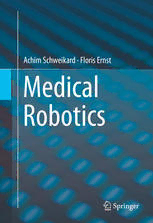Table Of ContentAchim Schweikard · Floris Ernst
Medical
Robotics
Medical Robotics
Achim Schweikard•Floris Ernst
Medical Robotics
123
AchimSchweikard FlorisErnst
InstituteforRobotics InstituteforRobotics
andCognitiveSystems andCognitiveSystems
UniversityofLu¨beck UniversityofLu¨beck
Lu¨beck,Germany Lu¨beck,Germany
ISBN978-3-319-22890-7 ISBN978-3-319-22891-4 (eBook)
DOI10.1007/978-3-319-22891-4
LibraryofCongressControlNumber:2015947502
SpringerChamHeidelbergNewYorkDordrechtLondon
©SpringerInternationalPublishingSwitzerland2015
Thisworkissubjecttocopyright.AllrightsarereservedbythePublisher,whetherthewholeorpartof
thematerialisconcerned,specificallytherightsoftranslation,reprinting,reuseofillustrations,recitation,
broadcasting,reproductiononmicrofilmsorinanyotherphysicalway,andtransmissionorinformation
storageandretrieval,electronicadaptation,computersoftware,orbysimilarordissimilarmethodology
nowknownorhereafterdeveloped.
Theuseofgeneraldescriptivenames,registerednames,trademarks,servicemarks,etc.inthispublication
doesnotimply,evenintheabsenceofaspecificstatement,thatsuchnamesareexemptfromtherelevant
protectivelawsandregulationsandthereforefreeforgeneraluse.
Thepublisher,theauthorsandtheeditorsaresafetoassumethattheadviceandinformationinthisbook
arebelievedtobetrueandaccurateatthedateofpublication.Neitherthepublishernortheauthorsor
theeditorsgiveawarranty,expressorimplied,withrespecttothematerialcontainedhereinorforany
errorsoromissionsthatmayhavebeenmade.
Printedonacid-freepaper
SpringerInternationalPublishingAGSwitzerlandispartofSpringerScience+BusinessMedia(www.
springer.com)
Preface
Medicalroboticsisaninterdisciplinaryfield,withmethodsfromcom-
puter science, mathematics, mechanical engineering, and medicine.
The field emerged in the 1980s as a new branch of robotics. Robotics
itself was then a branch of artificial intelligence. However, a number
of technical and mathematical problems had to be solved to bring ro-
botstoroutineclinicaluse.Theseproblemswerefaroutsidethescope
of artificial intelligence, and this supported the emergence of the new
field.
When comparing medical robotics to industrial robotics, we see that
the latter field is the one that sells most robots. By contrast, some
of the most challenging research problems arise in medical robotics:
thereisaneedforimprovingtheaccuracyofsurgicalprocedures,and
image guidance has become a central element of this. If we imagine
thatroboticexoskeletonscanhelpparalyzedpatients,itbecomesclear
that we will need methods for motion learning and brain-computer
interfaces.
Wewrotethisbookasatextbookforaone-semesterclassonmedical
robotics.Whenwriting thisbook,wewereguidedbytwothoughts:
• Computer scientists and engineers should learn to understand ap-
plicationdomains,andmedicineisanidealapplicationdomainfor
thispurpose.
• Thebookshouldbesuitableasafirstcourseinrobotics.
v
vi Preface
Comparingtostandardtextbooksonrobotics,fourelementshavebeen
added here: (1) seven-joint robots; (2) navigation, calibration, and re-
gistration;(3)connectiontomachinelearning;and(4)applicationsin
surgical robotics, rehabilitation robotics, and neuroengineering. The
textreliesentirelyonthemostelementarymathematicaltools,andwe
give a detailed introduction for each new method. At the end of each
chapter, we provide exercises, preparing the grounds for the tools in
thenextchapters,whilelinkingtothemethodsinthecurrentchapter.
Chapter1introducesthemainapplicationsofmedicalrobotics.
Chapter 2 presents basic methods for describing position and orient-
ation as well as forward robot kinematics. This includes matrices,
angles,andtheanalysisofsimplelinkages.
Chapter3introducesinversekinematicsforrobots.Wedevelopthein-
verse kinematics for a seven-joint lightweight robot, called the DLR-
Kuka arm. This robot is designed for applications requiring direct in-
teractionwithanoperator.Toobtainaninversesolution,wefirstsolve
the kinematic equations for a standard six-joint robot with revolute
joints, called the elbow manipulator with spherical wrist. We obtain
a building-block strategy with which common types of robots can be
analyzed.
Geometricmethodsforinversekinematicsareanalternativetoalgeb-
raic methods. We illustrate geometric methods for the kinematic ana-
lysisofcommonmedicaldevices.
In Chap.4, we consider Jacobi-matrices. There are two types of Jac-
obians: the analytic Jacobian and the geometric Jacobian. The ana-
lytic Jacobian offers alternative methods for the inverse analysis of
robots. The geometric Jacobian is a basic tool for velocity kinemat-
ics and for analyzing the relationship between joint torques and static
forces/torques acting at the tool. We apply the geometric Jacobian to
problemsinvolving C-armX-rayimagingandrobotdesign.
Chapter 5 establishes a connection to the classical tools from med-
ical imaging, i.e., MR, CT, ultrasound, and X-ray imaging. With this
toolset,weaddressseveralproblems,suchasnavigation,registration,
imagecalibration, androbotichand-eyecalibration.
Chapter 6 describes methods for treatment planning. Computer pro-
grams have been used for treatment planning in radiation oncology
since the 1950s. Until the 1990s, conventional systems for radiation
Preface vii
oncology irradiated tumors from a small set of beam directions (typ-
ically three to five directions). To move the beam source, five-joint
mechanisms with revolute and prismatic joints were used. This
changed with the introduction of robotic radiosurgery. Up to 1000
distinct directions can now be used in a single treatment. This greatly
increasedthecomplexity oftreatment planning.
Chapter 7 is the first chapter (in a series of three chapters) with basic
methods from machine learning. We address the problem of tracking
anatomical motion (heartbeat, respiration) with a robot. To this end,
we learn the motion of a difficult-to-image anatomical target via the
motionofasurrogate.
In Chap.8, we predict respiratory motion to compensate for the time
lag of the robot, while tracking a target. Again, machine learning is
one of the main elements. In addition, we need a connection to basic
methodsfromsignalprocessing.
In Chap.9, we consider motion replication. Robots for motion replic-
ationarethemostcommonlyusedsurgicalrobots.Thesurgeonmoves
a passive robot, and thereby issues motion commands to a small rep-
licatorrobot.Weapplytoolsfrommachinelearningtoclassifydiffer-
ent types of motions, i.e., intended motion, tremor, and noise. In the
replication process, we must separate these types of motions (all of
which are part of the motion signal). In the same context, we apply
thegeometricJacobiantotheanalysisofstaticforcesandtorques.
The three applications in Chaps.7–9 all converge to a set of meth-
ods, which we term “motion learning.” Humans learn motion, and it
is obvious that we need dedicated tools for motion learning not only
inmedicalrobotics.
Chapter 10 discusses integrated systems in medical robotics. The
methodsdevelopedinChaps.1–9arethebuildingblocksforsuchsys-
tems. It should be noted that the methods in Chaps.1–9 have already
found their way to the clinic, and have become routine tools, espe-
cially in oncology, but also in orthopedics and neurology, most of
themviatheconnectiontomedicalimaging andmotion learning.
Chapter 11gives anoverview of methods for neuroprosthetics, brain-
machineinterfaces,andrehabilitation robotics.
viii Preface
In the appendix, we derive the geometric Jacobian matrix for the six-
joint elbow manipulator and for the DLR-Kuka seven-joint robot. We
alsoincludesolutionstoselectedexercises.
Additional material is available at https://medrob-book.rob.uni-
luebeck.de.
Acknowledgements
We thank Max Wattenberg for converting many of the drawings to
TikZ-format, Robert Du¨richen for implementing several of the meth-
ods for motion prediction and for discussions on the subject, Ulrich
Hofmann and Christian Wilde for their help with writing the text
on brain-machine interfaces, Ivo Kuhlemann for his help with im-
plementing and testing inverse kinematics algorithms, and Cornelia
Rieckhoffforproof-reading.
We offer special thanks to Rainer Burgkart for discussions and sug-
gestions on orthopedic navigation, John R. Adler for many discus-
sionsonnavigationinneurosurgeryandradiosurgery,andourdoctoral
students Norbert Binder, Christoph Bodensteiner, Christian Brack,
Ralf Bruder, Markus Finke, Heiko Gottschling, Max Heinig, Robert
Hanne,MatthiasHilbig,PhilipJauer,VolkerMartens,LarsMattha¨us,
ChristophMetzner,LukasRamrath,LarsRichter,StefanRiesner,Mi-
chael Roth, Alexander Schlaefer, Stefan Schlichting, Fabian Schwar-
zer,BirgitStender,PatrickStu¨ber,BenjaminWagner,andTobiasWis-
selfortheirhelpwithexperimentsandgraphicsandforreadingdrafts
ofthebook.
Finally,wethankMohanBodduluri, GreggGlosser,andJamesWang
fortheirhelpwithimplementingroboticrespirationtrackingandtreat-
mentplanningforaclinicalstandardsystem.
Lu¨beck,Germany AchimSchweikard
FlorisErnst
Contents
1 Introduction 1
1.1 RobotsforNavigation ........................... 2
1.1.1 Navigation forOrthopedic Surgery........... 3
1.1.2 Radiologic Navigation ..................... 6
1.1.3 StereotaxicNavigation ..................... 11
1.1.4 Non-invasiveNavigation fortheHead ........ 14
1.1.5 Navigation forMovingTargets .............. 15
1.2 MovementReplication........................... 16
1.3 RobotsforImaging ............................. 17
1.4 Rehabilitation andProsthetics..................... 18
Exercises ........................................... 21
References.......................................... 27
2 DescribingSpatialPosition andOrientation 29
2.1 Matrices....................................... 29
2.2 Angles ........................................ 33
2.2.1 RelativePositionandOrientation ............ 34
2.3 Linkages ...................................... 37
2.4 Three-JointRobot............................... 42
2.5 StandardizingKinematicAnalysis ................. 45
2.6 Computing JointAngles ......................... 48
2.7 Quaternions.................................... 50
Exercises ........................................... 54
ix

